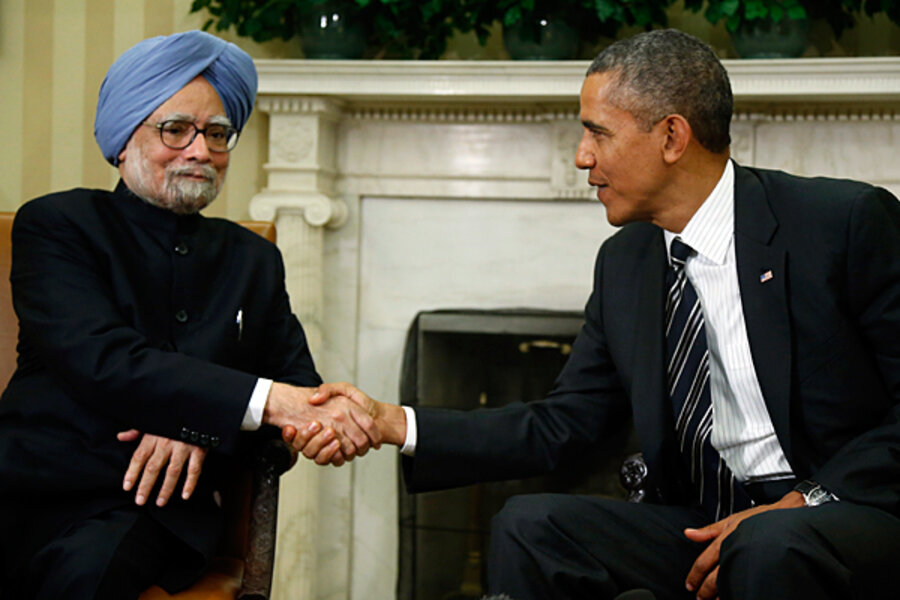New life for old ties: Are India and the US about to improve relations?
Loading...
| New Delhi
As India’s Prime Minister Manmohan Singh meets with US President Obama in Washington today, analysts see it as part of a larger sign that New Delhi is ready to repair recently frayed US-India economic ties.
In 2005, President George W. Bush pushed for India to become the only country to get a waiver from the Nuclear Suppliers Group to receive civil nuclear fuel without having signed the Non-Proliferation Treaty. Relations between the US and India became strained when the US sensed it did India a huge favor but got little in return: Not only did India slam the US with hefty liability fines on the fuel it helped India secure, but India did not pursue promised economic reforms to create more opportunities for US business.
But, on the eve of his visit to the US, Prime Minister Singh allowed for a key sticking point in the relationship to come unstuck, and analysts are hopeful that this could grease ties – at least a bit.
“This visit is incremental, not transformational,” says Samir Saran, vice president of the Observer Research Foundation, a leading New Delhi think-tank.
The Indian Parliament ratified the Indo-US civil nuclear deal - the same deal that President Bush was behind – in 2008. Then, two years later, it passed a nuclear liability law that imposed liability on nuclear fuel suppliers’ with heavy financial damages in case of a nuclear accident.
Dismay in Washington about this stalled the deal, but Singh reinterpreted the law to mean Indian nuclear companies could negotiate the scope and extent of liability on the nuclear fuel supplier on a case-by-case basis.
"Fuel suppliers have a point that the global practice is [a] liability for the plant operator," says C. Uday Bhaskar, a leading Indian foreign policy commentator explaining the Indian viewpoint. “An accident can be of three kinds – material related, operations related, or unforeseen exigencies such as natural disasters, as was the case in Fukushima,” says Mr. Bhaskar adding that leaving it for the plant operator to decide the terms and extent of liability is a move that makes sense.
Analysts say that it may still be a while before there are nuclear fuel transfers to India. But, says Ron Somers, chief of the Indo-US Business Council, this is a solid step forward. "This is progress and we have to be patient with one another's democracy," he says.
And it comes at a key time. Many in New Delhi believe that the many policymakers in the US are not actually happy about the Indo-US nuclear deal.
“Over the past few years, voices have grown louder in Washington [saying] that the exception for India was misplaced,” says Mr. Saran.
In June, 170 US lawmakers complained to President Obama that Indian import policies in a variety of sectors were hurting US jobs. And on a visit to India in July, Vice President Joe Biden pointed out that India seemed reluctant to open up to US business. India responded by finally allowing foreign direct investment in single-brand retail, thus opening (somewhat controversially) doors for Wal-Mart to set up shop in India.
Analysts say India looks less attractive today because its economic growth has nearly halved to 4.4 percent partly because the Singh government has been unable to pursue economic reform. An economic turnaround is not expected before the April 2014 general elections.
Analysts say a true boost in relations hinges on a preliminary business agreement between US-based Westinghouse Electric Co. and the state-owned Nuclear Power Corporation of India to set up a nuclear power plant in India's Gujarat state. The Indian government is keen to use nuclear energy to meet its massive power shortfall.
While India is still pressing for US visa restrictions on skilled workers to be relaxed, India has admitted it needs to do more to address US concerns over trade ties. At $60 billion, Indo-US trade is one-eighth the size of US-China trade.
"It arises from the macro-economic situation. US friends mention concerns about economic reforms and specific policy issues in India. These concerns are not unique to the US. They are, first and foremost, of concern to Indians," India's National Security Adviser Shivshankar Menon said.






